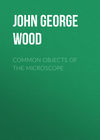Czytaj książkę: «The Common Objects of the Country», strona 6
CHAPTER VI
THE PUSS-MOTH—CURIOUS CATERPILLAR—A STRONG FORTRESS—THE BURNET-MOTH—OAK EGGER—HOW TO KILL INSECTS—TWOFOLD LIFE—VICTIMS OF LOVE—ACUTE SENSES—THE STORY OF INSECT LIFE—DRINKER MOTH—CATERPILLAR BOX—EMPEROR MOTH—TYPE OF THE MOUSE-TRAP.
Just at the right hand of the Tiger-moth, on plate B, may be seen a caterpillar of a very strange and eccentric form, and marked by the number 4 a. This is the larva or caterpillar of the Puss-moth, and is no less beautiful in colouring than fantastic in form. Its attitude, too, when it is at rest, is quite as curious as its general appearance.
While eating, it sits on the leaves and twigs much as any other caterpillar; but when it ceases to feed, and reposes itself, it grasps the twig firmly with the claspers with which the hinder portion of its body is furnished, and raises the fore-part of its body half upright. In this attitude it much resembles that of the Egyptian Sphinx, and from this circumstance the moth itself is called a Sphinx. An old gardener was once quite put out of temper by seeing several of these caterpillars for the first time, because they had so consequential an air.
The colouring of this creature varies according to the time of year; but it may be easily recognised by its form alone, which is very peculiar.
One of the most remarkable points in the creature is the forked apparatus at the end of the tail, and which frightens people who do not know the habits of the caterpillar. These forks are black externally, and rather stiff, but are only sheaths for two curious rose-coloured tentacles, which are usually kept hidden, but which may be seen by touching the caterpillar with the point of a needle. When the creature is thus irritated, it will protrude these tentacles from their sheath, and will then strike the part that had been touched.
It is supposed that this apparatus is intended as a kind of whip, wherewith to drive away the ichneumon flies, and other parasites, that inflict such annoyance on many caterpillars.
When this caterpillar proceeds to its pupal state, it makes itself a wonderful fortress—not suspended like that of the Tiger-moth, nor hidden in a dark spot; but it boldly fixes its residence on the exterior of the tree on which it feeds, trusting to its similitude to the bark for concealment, and to the strength of its habitation for safety, even if discovered.
It is furnished with a gummy substance, something after the manner of the silk of the Tiger-moth; but instead of spinning that substance into threads, it uses it in the following manner.
Biting little chips of wood from the bark of the tree, the caterpillar glues them together with this natural cement; and so builds an arched house for itself, much about the size and shape of half a walnut-shell. So strongly compacted is this residence, that rain and wind have no effect on it, and a penknife does not find an easy entrance.
One or two of these caterpillars which I brought home modified their dwellings in a curious manner. One of them nibbled to pieces a portion of a cardboard box, and so made a kind of papier-maché house; while others, who were placed under a glass tumbler, and upon a stone surface, simply made their house of the hardened gum. In this state, it appeared as if it had been made of thin horn, and was so transparent that the chrysalis could be seen through the walls.
The caterpillar is common enough, and may be found on the willow or poplar. And a sharp eye will soon learn to detect the winter house, which to an unpractised eye looks as if it were merely a natural excrescence on the bark.
If one of these habitations is found, the best mode of removing it is to avoid touching the dwelling itself, but to cut away the bark round it; and then, by inserting the point of a stout knife, gently raise up the house, together with the bark on which it is placed. This is one of the modes by which an entomologist may find employment even during the winter months, and others will be mentioned in the course of this work.
The moth itself may be seen figured on plate B, fig. 4. It is called the Puss-moth, on account of the soft furry down with which its body is covered, and it is fancifully thought to resemble the fur of the cat.
It is rather a difficult moth to preserve effectually, as it is apt to become “greasy”—that is, to have its whole beauty destroyed by an oiliness that exudes from the body, and gradually creeps even over the wings. The best preservative is to remove the contents of the abdomen, and stuff it with cotton-wool that has been scented with spirits of turpentine. But even that plan is rather precarious, and the delicate, downy plumage is apt to be sadly damaged during the process of stuffing.
Still keeping to the same plate, and referring to the right-hand corner at the top, a moth of strange aspect will be seen; and immediately below it an object that somewhat resembles the hammock of the Tiger-moth, affixed in a perpendicular instead of an horizontal direction. This moth is called the Burnet-moth, and the hammock is the pupa case of the same insect.
The colouring of this moth is very rich and beautiful. The two upper wings are green, and of a tint so deep that, like green velvet, they almost appear to be black. On each of these wings are several red spots, varying in number according to the species; some wearing six spots, and others only five. The two under wings are of a carmine red, edged with a border of black, in which is a tinge of steely blue. The body is velvety black, with the same blue tint.
The moth is rather local; but when one is found in a field, hundreds will certainly be near.
At the best of times it is not an active insect, and on a cold or a dull day hundreds of them may be seen clinging to the upright grass stems, from which they can be removed at pleasure.
The caterpillar of this beautiful moth keeps close to the ground, and feeds on grasses, the speedwell, dandelion, and other plants. When it is about to become a pupa, it ascends some slender upright plant, generally a grass stem, and then spins for itself the residence which is represented on the plate.
In this state it may be gathered, and placed under a glass shade; and in the summer months the perfect insect will make its appearance. There are some places which it specially favours, and where it may be found in great profusion. At Hastings, for example, the fields about the cliffs were so populated by these moths, that hardly a grass stem was without its Burnet-moth’s habitation.
Feeding on the same plant as the Tiger-moth caterpillar, may often be found another caterpillar of a very different aspect. It is very much larger, and instead of presenting an array of stiff bristles, is covered with thick soft hair of a yellowish-brown colour, diversified with stripes of a deep velvety black, arranged so as to resemble the slashed vestments that were so fashionable some centuries ago.
This caterpillar is the larva of the Oak Egger-moth, and is not so remarkable as a caterpillar as for the house which it builds for its pupal residence.
After changing its skin the requisite number of times, the caterpillar ceases to feed, and, proceeding to some convenient spot (generally a faded thorn-branch), spins its temporary habitation. This cocoon, as it is called, is about an inch in length; and into that narrow space the creature contrives to push, not only itself, but also its last and largest skin.
The substance of the cocoon is hard and rather brittle when dry; and in texture somewhat resembles thin brown cardboard. In its substance, and on its surface, are woven many of the hairs with which the caterpillar is furnished. If the cocoon is carefully opened, the chrysalis will be found within, its head towards the spot where the moth is to emerge, and the cast caterpillar-skin crumpled down by its tail.
In course of time, the chrysalis passes through its development, and the egger-moth itself pushes its way out of the cocoon, with wings and body wet and wrinkled, but soon to assume their proper form and strength. The cocoon is shown at plate I, fig. 5 a.
Sometimes the cocoon remains unbroken beyond the proper season; and if it is examined, one or two little holes will generally be found in it. These are signs that the egger has met with an untimely fate, and that it has fallen a victim to those scourges of the insect world, the ichneumon flies. Of these creatures we shall speak in a future page, and therefore omit to describe them here. The moth is shown at fig. 5.
If the moth is intended to be killed, and then placed in a cabinet, the use of sulphur must be avoided. It kills the moth, certainly; but it kills the colours also, and quite ruins its appearance. Sulphur is always a dangerous instrument in insect-killing, and should on no account be used. There are many ways of destroying insects humanely, and extinguishing their life as if by a lightning flash; but these modes vary according to the size, sex, and nature of the insect. Some of them I will here mention.
If the insect is a beetle, it may be plunged into boiling water, or into spirits of wine, in which a very little corrosive sublimate has been dissolved. Both modes will destroy the life rapidly, but the former is the better of the two. When walking in the fields or woods, a wide-mouthed, strong bottle, about half full of spirits of wine, is a useful auxiliary, as all kinds of beetles, and even flies and bees, can be put into it; and if dried in a thorough draught, will look as well as before. If this precaution be not taken, all the insects that have long hair, as the humble-bee and others, will lose their good looks, and their hair will be matted together in unseemly elf-locks.
Butterflies, and most of the Diptera, or two-winged flies, can be instantaneously killed by a sharp pinch on the under-surface of the thorax among the legs, as the great mass of nerves is there collected. Many people seem to fancy that the head is the vital part in an insect; and having pinched or run a pin through its head, they think that they have effectually slain the creature, and marvel much to see it lively some twenty-four hours afterwards.
Especially is this the case with the large-bodied moths, whose vitality is quite astonishing. You may even stamp upon them, and yet not crush the life out of that frail casket. If you drive the life out of one-half of the creature, it only seems to take refuge in the other; and then retain a more powerful hold, like a garrison driven into a small redoubt.
It is not at all uncommon to find one of these moths dead and dry as to its wings and limbs, which snap like withered sticks if touched, and yet with so much life in it as to writhe its abdomen if irritated, and to deposit its eggs just as if it were in full activity.
Indeed, so strong is this power that the creature seems to be gifted with a double life, one for itself and the other for its progeny. The former is comparatively weak, and but loosely clings to its home; but the latter intrenches itself in every organ, penetrates every fibre, and, until its great work is completed, refuses to be expelled. So, unless the entire mechanism of the insect be killed, the poor creature may live for days in pain.
Fortunately, there is a mode of so doing; and this is the way of doing it:—
Make a strong solution of oxalic acid, or get a little bottle of prussic acid—it is the better of the two, if you have discretion as beseems a naturalist. Also make a bone or iron instrument, something like a pen, but without a nib. Dip this instrument into the poison as you would a pen, and then you have a weapon as deadly as the cobra’s tooth, and infinitely more rapid in its work. Now hold your moth delicately as entomologists hold moths, near the root of the wings. Keep the creature from fluttering; plunge the instrument smartly into the thorax, between the insertion of the first and second pair of legs; withdraw it as smartly, and the effect will be instantaneous. The moth will stretch out all its legs to their full extent; there will be a slight quiver of the extremities; they will be gently folded over each other; and you lay your dead moth on the table.
The reason of this rapid decease is of a twofold nature.
In the first place, the chief nerve mass is cut asunder, and even thus a large portion of the life is destroyed. But the chief breathing tubes are also severed, and a drop of poison deposited at their severed portions. Consequently, at the next inspiration, either the poison itself or its subtle atmosphere rushes to every part, and to every joint of the insect, thus carrying death through its whole substance.
The male insect is very different in appearance to the female, and in general is hardly more than two-thirds of her size. The colours, too, are very different; for in the male insect the wings are partially of a dark chestnut brown, with a light band running round them, as may be seen in the engraving; while in the female the wings are almost entirely of a uniform yellowish brown.
The antennæ, too, of the male are deeply cleft, like the teeth of a comb; while those of the female are narrow, and comparatively slightly toothed.
As is the case with several other moths, the male oak eggers are sad victims to the tender passion, and fall in love not only at first sight, but long before they see the object of their affection at all.
If a female egger is caught immediately after her entrance into the regions of air, and placed in a perforated box near an open window, her unseen charms will be so powerfully felt by gentlemen of her own race that they will flock to the casket that contains their desired treasure, and fearlessly run about it, fluttering their wings, and striving to gain admission. So entirely do they abandon themselves to the captivity of love, that they do not fear the risk of a bodily captivity, and will suffer themselves to be taken by hand, without even an endeavour to escape.
Carry the imprisoned moth into the fields, and even there the eager suitors will arrive from all quarters, and boldly alight on the box while in the hand of the entomologist.
More wonderful must be the influence that can emanate from so small a creature, and extend to so great a distance—an influence which, although entirely inappreciable by any human sense, exercises so potent a sway on all sides, and to so great a distance.
The conditions, too, of this mysterious influence are singularly delicate; for after the moth has once found her mate, she may be placed amid a crowd of gentlemen, and not one will take the least notice of her.
Like the young beauty of the ball-room, who whilom attracted to herself crowds of beaux, that fluttered around her, and contended with each other for a look or a smile of their temporary divinity, but who finds herself deserted by the fickle crowd when her election is made; so our Lady Lasiocampa Quercus, after setting all hearts ablaze for a time, makes happy one favoured individual, is deserted by the many rejected, and left in quiet to the duties of a wife and a mother.
Her married life is but short, for her husband rarely survives his happiness more than a few hours, and she, after making due preparation for the welfare of her numerous family, whom she is never to see, feels that she has fulfilled her destiny, and gives up a life which has now no further object.
There is really something very human in the life even of an insect. Many a life story have I watched in the insect world, which, if transferred to the human world, would be full of interest. There is also one great advantage in the insect life, namely, that as it only consists of a year or two, the events of several successive generations come under the observation of a single historian.
First, a number of tiny, purposeless beings come into the world, spreading about much at random, and seeming to have no other object except to eat. It is but just to them to say that they don’t cry, and are always contented with the food that is given them.
They rapidly increase in size, pass through a regular series of childish complaints, which we mass together under this single term, “moulting,” but which are probably to their senses as distinct as measles, and chicken-pox, and hooping-cough.
They outgrow a great many suits of clothes in a wonderfully short period; they retire for a time to finish their education; and then come before the world in all the glory of their new attire.
Up to this time they are nearly exactly alike in habits and manners; but, when freed from the trammels that held them, they diverge, each in his appointed way, each exulting for a short space in the buoyancy of youth, and fluttering indeterminately in the new world, but soon settling down to the business for which they were made.
So even in insects a human soul can find a companionship, and a solitary man need never feel entirely alone as long as he can watch the life of a humble moth, and see in that despised creature some manifestations of the same feelings which actuate himself.
And it even seems that, through this companionship, the higher nature communicates itself in some degree to the lower, as is shown by the many instances of men who have tamed spiders and other creatures quite as far removed from the human nature. In such a case it seems very clear that either the higher nature gives to the lower an intelligence not its own, or that it develops powers which would have lain dormant had they not been called forth by the contact of a superior being.
This subject is a very wide one, and well worth following up. But as it runs through the whole creation, and this book is only to consist of a few pages, it must suffice merely to put forth the idea.
To pass to another insect.
On plate E, and fig. 1 and 1 a, may be seen an insect which somewhat resembles the oak egger-moth, and is often mistaken for it by inexperienced eyes. This is the “Drinker” moth, remarkable for the thick furry coat which it wears, as a caterpillar and as a moth, and which it employs in the construction of its cocoon. This moth is one of my particular friends; and I have had hundreds of them from the egg to their perfect state. I had quite a large establishment for the education and development of lepidoptera, and especially favoured the tiger-moth, the oak egger, and the drinker.
The caterpillar of this moth is entirely covered with dense hair, even down to the very feet; and by means of this protection it is enabled to brave the winter frost, needing not to pass the cold months in a torpid state. It is a pretty caterpillar, and very easily recognised by the figure. Its chief peculiarities are the two tufts of hair that it bears at its opposite extremities, and the double line of black spots along its sides.
Generally, it feeds on various grasses, but it is not dainty, as are many caterpillars; and I have always found it to eat freely of the same food as the oak egger larva. This caterpillar is seen at fig. 1 b.
When alarmed, it loosens its hold of the plant on which it is feeding, rolls itself into a ring, and drops to the ground, hoping to evade notice among the foliage. This habit used to be rather perplexing to me, not because the creature could escape by so well-known a trick, but because it would not go into the box prepared for its reception.
It is necessary to have a box of a peculiar form for the collection of caterpillars. If the lid is raised every time that a fresh capture is made, difficulties increase in proportion to the number of caterpillars. For, when some thirty larvæ are in the box, they all begin to crawl out when the lid is opened; and Hercules had hardly a more bewildering task among the hydra’s heads than the entomologist among his captives.
No sooner is the light admitted, than a dozen heads are over the side; and as fast as one is replaced, six or seven more make their appearance. The only remedy is to sweep them all back with a rapid movement of the hand, to shake them all to the bottom, and then to replace the lid as fast as possible. Even with all precaution, caterpillars are crushed; and, besides, they are delicate in their constitutions, and require gentle handling.
So the best plan is to have a tin box made with a short tube, through which the caterpillars can be introduced, and which can be stopped by a cork when the creatures are fairly inside.
Now, although this is a capital contrivance for caterpillars that hold themselves straight, it fails entirely when they curl themselves into a ring and refuse to be straightened. It is as impossible to straighten a rolled-up hedgehog as a caterpillar in a similar attitude; and if force is used in either case, the creature will be mortally injured. However, gentle means succeed when violence fails, with insects as with men. A Bheel robber will steal the bedding from under a sleeping man without waking him; and, by an analogous process, the refractory caterpillar is lodged in his prison before he is fairly awake to his condition.
The entomologist feels a justifiable pride in executing similar achievements; for there is quite as much force of intellect needed to outwit a caterpillar as a quadruped.
When the drinker caterpillar passes into its pupal state, it makes for itself a very curious cocoon, not unlike a weaver’s shuttle in shape, being large in the middle, and tapering to a point at each end. The texture is soft and flexible, as if the cocoon were made of very thin felt, and the larval hairs are quite distinguishable on its surface. The moth leaves the cocoon about August. For the cocoon see fig. 1 c.

COCOON OF THE EMPEROR MOTH.
I found that few caterpillars are so liable to the attack of ichneumon flies as those of the drinker moth. A cocoon now before me is pierced with thirteen holes from which ichneumon flies have issued, having eaten up the caterpillar. The eggs are shown in fig. 1 e.
If the reader will now refer to plate C, the central figure will be found to represent a strikingly handsome moth, called, from its gorgeous plumage, the “Emperor Moth”.
Its body is covered with a thick downy raiment, and the wings are clothed with plumage of a peculiarly soft character, which is well represented in the figure. The antennæ, too, are elaborately feathered.
Although the beauty of this insect would entitle it to notice in its perfect state, and the peculiar shape of its larva—(see plate C, fig. 4 a)—would draw attention, yet its chief title to admiration lies in the cocoon which it constructs for its pupal existence.
Externally, there is nothing remarkable in the cocoon; and, as may be seen in the same plate, fig. 4 b, it is a very ordinary, rough, flask-shaped piece of workmanship. But if the outer covering be carefully removed, or if the cocoon be divided lengthways, a very wonderful structure is exhibited.
The inventor of lobster-pots is not known, and history has failed to record the name of the man who first made wire mouse-traps with conical entrances, into which the mice can squeeze themselves, but exit from which is impossible.
But, though the principle had not been applied to lobsters or mice, it was in existence ages upon ages ago. Before human emperors had been invented, and very probably long before mankind had been placed on our earth, the caterpillar of the emperor moth wove its wondrous cell, and thereby became a silent teacher to the cunning race of mankind how to make mouse-traps and lobster-pots.
For inside the rough outer case, which is composed of silken threads, woven almost at random, and very delicate, is a lesser case, corresponding in shape with its covering, but made of stiff threads laid nearly parallel to each other, their points converging at the small end of the case. See the cut on p. 125.
It will now be seen that the moth when it leaves its chrysalid case can easily walk out of the cocoon, but that no other creature could enter. So within its trapped case the chrysalis lies secure, until time and warmth bring it to its perfection. It breaks from its pupal shell, walks forward, the threads separate to permit its egress, and then converge again so closely that to all appearance the cocoon is precisely the same as when the moth was within.
Now, any observant member of the human race, who had been meditating upon traps, and happened in a contemplative mood to open one of these cocoons, would feel a new light break in upon him, and, Archimedes-like, he would exclaim “Eureka,” or its equivalent, “I have found my trap!” Reverse the process, make the converging threads to lead into instead of out of the trap, and the thing is done. “I will make it of wire, put it on my shelf, and I catch mice and rats. I will make it of osier, sink it to the bottom of the sea, and I catch lobsters and crabs. I will lay it in a rapid, and I catch roach and dace; I will place it under the river banks, and then I have cray-fish.”
So might he soliloquise on the future achievements of his newly-discovered principle. But unless he had the prophetic afflatus strong within him, never would he imagine that in future times his discovery would catch a monarch and an Elector to boot.















